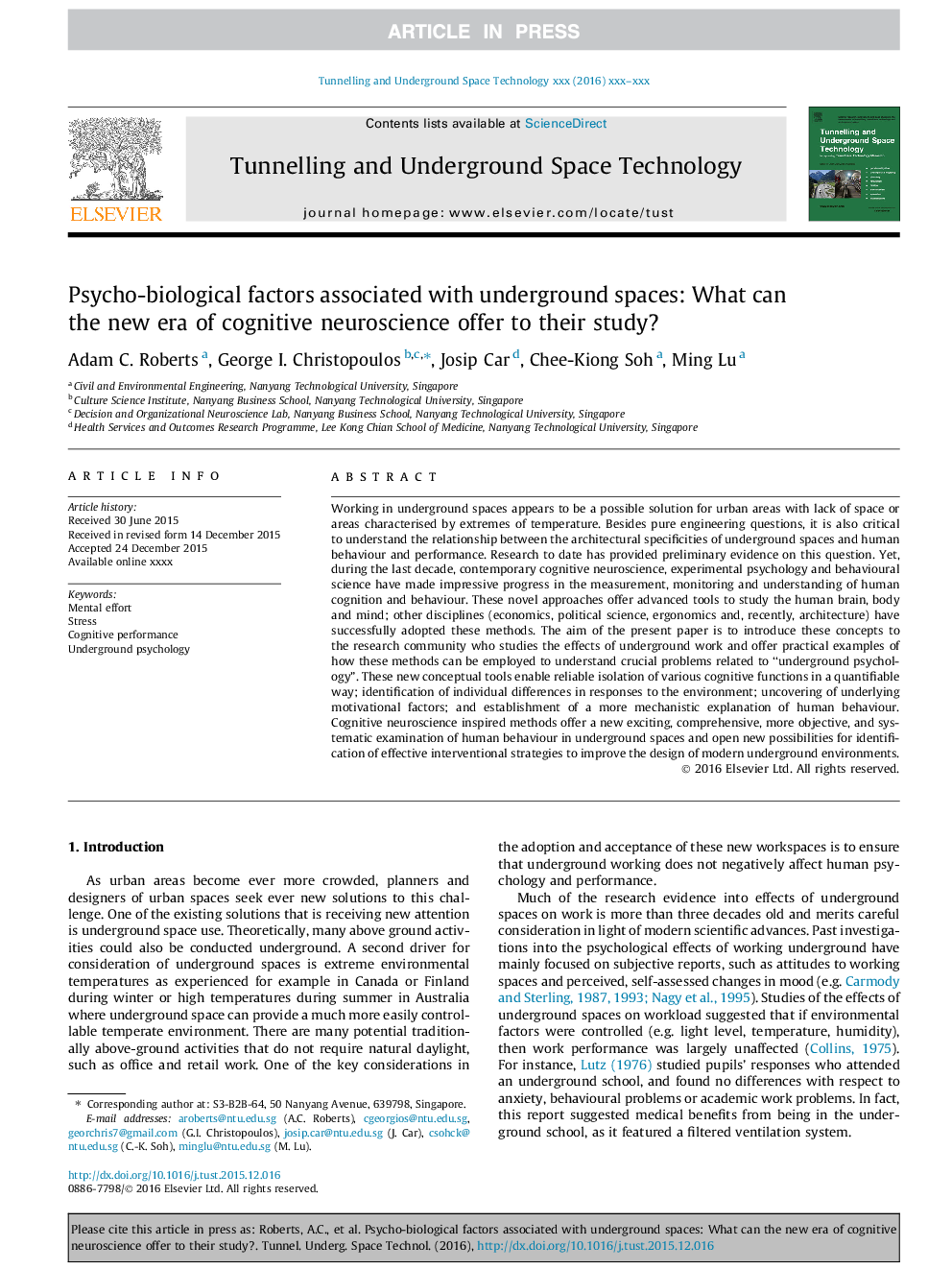| کد مقاله | کد نشریه | سال انتشار | مقاله انگلیسی | نسخه تمام متن |
|---|---|---|---|---|
| 6783589 | 534181 | 2016 | 17 صفحه PDF | دانلود رایگان |
عنوان انگلیسی مقاله ISI
Psycho-biological factors associated with underground spaces: What can the new era of cognitive neuroscience offer to their study?
ترجمه فارسی عنوان
عوامل روانی-بیولوژیکی مرتبط با فضاهای زیرزمینی: چه چیزی می تواند عصر جدید علوم اعصاب شناختی را به مطالعه خود ارائه دهد؟
دانلود مقاله + سفارش ترجمه
دانلود مقاله ISI انگلیسی
رایگان برای ایرانیان
کلمات کلیدی
تلاش ذهنی، فشار، عملکرد شناختی، روانشناسی زیرزمینی،
ترجمه چکیده
کار در فضاهای زیرزمینی به نظر می رسد یک راه حل ممکن برای مناطق شهری با کمبود فضا یا مناطق مشخص شده توسط شدت درجه حرارت است. علاوه بر مسائل مربوط به مهندسی خالص، برای شناخت رابطه بین ویژگی های معماری فضاهای زیرزمینی و رفتار و عملکرد انسان نیز مهم است. تحقیقات تا به امروز شواهد اولیه در این مورد ارائه کرده است. با این حال، در طول دهه گذشته، علوم اعصاب شناختی معاصر، روانشناسی تجربی و علوم رفتاری پیشرفت قابل توجهی در اندازه گیری، نظارت و درک شناخت و رفتار انسان داشته اند. این روش های جدید، ابزار پیشرفته ای را برای مطالعه مغز، بدن و ذهن انسان ارائه می دهند؛ رشته های دیگر (اقتصاد، علوم سیاسی، ارگونومی و اخیرا معماری) این روش ها را با موفقیت به کار گرفته اند. هدف مقاله حاضر، معرفی این مفاهیم به جامعه پژوهشی است که اثرات کار زیرزمینی را مورد مطالعه قرار می دهد و نمونه های عملی از چگونگی استفاده از این روش ها برای درک مسائل مهم مربوط به روان شناسی زیرزمینی ارائه می دهد. این ابزارهای مفهومی جدید، انعطاف پذیری قابل قبول از توابع شناختی مختلف را به شیوه ای قابل اندازه گیری امکان می دهد؛ شناسایی تفاوت های فردی در پاسخ به محیط زیست؛ کشف عوامل انگیزشی پایه؛ و ایجاد یک توضیح مکانیکی از رفتار انسان. روشهای الهامبخش علوم اعصاب شناختی، بررسی جدید هیجان انگیز، جامع، دقیق و منظم رفتار انسانی در فضاهای زیرزمینی را ارائه می دهند و فرصت های جدیدی برای شناسایی راهکارهای مداخلۀ مداخله ای برای بهبود محیط های مدرن زیر زمینی ارائه می دهند.
موضوعات مرتبط
مهندسی و علوم پایه
علوم زمین و سیارات
مهندسی ژئوتکنیک و زمین شناسی مهندسی
چکیده انگلیسی
Working in underground spaces appears to be a possible solution for urban areas with lack of space or areas characterised by extremes of temperature. Besides pure engineering questions, it is also critical to understand the relationship between the architectural specificities of underground spaces and human behaviour and performance. Research to date has provided preliminary evidence on this question. Yet, during the last decade, contemporary cognitive neuroscience, experimental psychology and behavioural science have made impressive progress in the measurement, monitoring and understanding of human cognition and behaviour. These novel approaches offer advanced tools to study the human brain, body and mind; other disciplines (economics, political science, ergonomics and, recently, architecture) have successfully adopted these methods. The aim of the present paper is to introduce these concepts to the research community who studies the effects of underground work and offer practical examples of how these methods can be employed to understand crucial problems related to “underground psychology”. These new conceptual tools enable reliable isolation of various cognitive functions in a quantifiable way; identification of individual differences in responses to the environment; uncovering of underlying motivational factors; and establishment of a more mechanistic explanation of human behaviour. Cognitive neuroscience inspired methods offer a new exciting, comprehensive, more objective, and systematic examination of human behaviour in underground spaces and open new possibilities for identification of effective interventional strategies to improve the design of modern underground environments.
ناشر
Database: Elsevier - ScienceDirect (ساینس دایرکت)
Journal: Tunnelling and Underground Space Technology - Volume 55, May 2016, Pages 118-134
Journal: Tunnelling and Underground Space Technology - Volume 55, May 2016, Pages 118-134
نویسندگان
Adam C. Roberts, George I. Christopoulos, Josip Car, Chee-Kiong Soh, Ming Lu,
